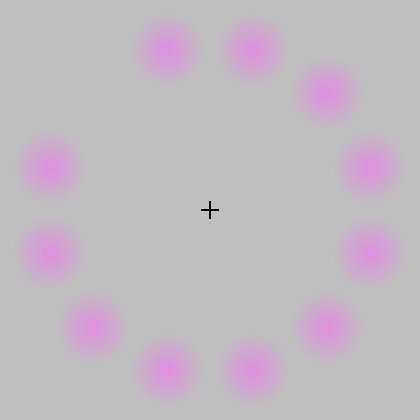Phi phenomenon

The phi phenomenon is the optical illusion of perceiving a series of still images, when viewed in rapid succession, as continuous motion. Max Wertheimer, one of the three founders of Gestalt psychology, defined this phenomenon in 1912.[1] The phi phenomenon and persistence of vision together formed the foundation of Hugo Münsterberg's theory of film[2] and are part of the process of motion perception.
The phi phenomenon is similar to beta movement in that both cause sensation of movement. However, the phi phenomenon is an apparent movement caused by luminous impulses in sequence, whereas beta movement is an apparent movement caused by luminous stationary impulses.[3]
Persistence of vision
Persistence of vision, which is popularly taught as the reason for motion illusion, is in reality merely the reason that the black spaces that come between each "real" movie frame are not perceived, which makes the phi phenomenon the true reason for motion illusion in cinema and animation, including the phenakistoscope, zoetrope, and others.
Experimental demonstration
The classic phi phenomenon experiment involves a viewer or audience watching a screen, upon which the experimenter projects two images in succession. The first image depicts a line on the left side of the frame. The second image depicts a line on the right side of the frame. The time/lag (the inter-stimulus interval, ISI) between offset of the first and onset of the second line is varied. Once both images have been projected, the experimenter asks the viewer or audience to describe what they saw. This percept changes with the duration of the lag between presentation of the first and second line.
With very little time passing between the two presentations (ca. 0-30ms in the original study, Steinman et al. 2000), a viewer will report to perceive the two lines simultaneously. Just before the two lines are no longer perceived simultaneously, the phi phenomenon occurs: Although both lines are perceived to be stationary and simultaneous, motion is perceived between them. This motion is described as having direction (from the earlier presented line to the later presented line) but to not be bound to an object. It was therefore also described as 'pure' motion, that is motion that is not bound to an object.
This observation lead Wertheimer to suggest that the perception of motion is 'as primary as any other sensory phenomenon' (Boring, 1942; in: Steinman et al. 2000). To explain: Touch can be felt without seeing (hearing, smelling, ...) that one is being touched. In that sense, it is 'primary' in that it does not rely on any other sense to be perceived. Likewise, phi motion is perceived without seeing an object moving, making it similarly 'primary' according to Wertheimer (1912).
If the lag between consecutive presentations is prolonged further, ('beta' / 'optimal') motion is perceived. The line in position A is perceived to move to position B. In the original experiments of Wertheimer (1912), a lag of 60 ms was found to be optimal to obtain this kind of percept. If the lag is further prolonged, two forms of partial movement can be perceived: dual movement and singular movement. In dual movement, two lines are perceived that both move, but not in a continuous way (like from A to B). In singular motion, two lines are perceived of which only one is moving. Finally, from a lag of around 200 ms in the original study onwards, the two lines are perceived to occur in succession—first A, then B.
See also
References
- ↑ Wertheimer, Max (April 1912). "Experimentelle Studien über das Sehen von Bewegung" [Experimental Studies on Motion Vision] (PDF). Zeitschrift für Psychologie. 61 (1): 161–265.
- ↑ Münsterberg, Hugo (1916). The Photoplay: A Psychological Study (PDF). New York: D. Appleton & Co. pp. 62–69.
- ↑ Steinman, R. M., Z. Pizlo, and F. J. Pizlo (2000). Phi is not beta, and why Wertheimer's discovery launched the Gestalt revolution: a minireview. Vision Research.
Further reading
- Boring, E. G. (1942). Sensation and perception in the history of experimental psychology. New York: Appleton, Century, Crofts.
External links
- (archived) The Myth of Persistence of Vision Revisited – A detailed explanation of how the perception of motion in film and video differs from the simplest notions of "persistence of vision", with mention of the erroneous use of phi as a revised explanation.
- Phi phenomenon activity – Application that lets us change some parameters to experiment with the phi phenomenon.